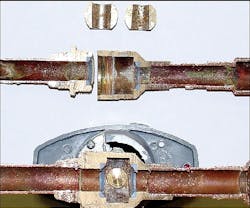Lead in Fixtures May Go Undetected
Some brass devices in plumbing systems can leach high levels of lead into drinking water, even in brand-new buildings, according to a new research study by Virginia Tech and the University of North Carolina at Chapel Hill.
Chapel Hill staff discovered high lead in the water of some new buildings in 2007 and asked Virginia Tech to help diagnose and fix the problem. The team developed a flushing protocol to ensure that before buildings are occupied, all new faucets and water fountains must meet the EPA’s rule of fewer than 15 parts per billion of lead.
Chapel Hill then discovered an unusually severe problem in mid-2008 involving two drinking fountains in a new lab building; one had lead levels over 300 parts per billion, miles above the EPA’s limit of 15 parts per billion. Flushing and other conventional remedies didn’t fix the issue, leading researchers to discover that a ball valve in the building’s piping system contained about 18% lead by weight on the inner surfaces that came into contact with the drinking water, even though the average overall lead content of the valve was just under the 8% limit allowed by law.
Chapel Hill and Virginia Tech caught the problem before anyone was exposed to the high levels of lead, but the researchers believe their discovery demonstrates that current lead regulations are too lax.
"In most other cases, the issue would go undetected," says Marc Edwards, UNC’s Charles Lunsford Professor of Civil Engineering. "The fact that some defective products listed as safe could be installed in schools and day care centers and harm children is very troubling."
To read the rest of the study, which was published in the November 2010 issue of the Journal of the American Water Works Association, visit www.awwa.org.
